Entry Database : PDB / ID : 6c1cTitle FGFR1 kinase complex with inhibitor SN37116 Fibroblast growth factor receptor 1 Keywords / / Function / homology Function Domain/homology Component
/ / / / / / / / / / / / / / / / / / / / / / / / / / / / / / / / / / / / / / / / / / / / / / / / / / / / / / / / / / / / / / / / / / / / / / / / / / / / / / / / / / / / / / / / / / / / / / / / / / / / / / / / / / / / / / / / / / / / / / / / / / / / / / / / / / / / / / / / / / / / / / / / / / / / / Biological species Homo sapiens (human)Method / / / Resolution : 2.15 Å Authors Yosaatmadja, Y. / Smaill, J.B. / Squire, C.J. Funding support Organization Grant number Country Health Research Council (HRC)
Journal : To Be Published Title : Understanding the structural requirements for covalent inhibition of FGFR1-3Authors : Yosaatmadja, Y. / Squire, C.J. / Patterson, A.V. / Smaill, J.B. History Deposition Jan 4, 2018 Deposition site / Processing site Revision 1.0 Jan 16, 2019 Provider / Type Revision 1.1 Jan 1, 2020 Group / Category / Item Revision 1.2 Oct 4, 2023 Group / Database references / Refinement descriptionCategory chem_comp_atom / chem_comp_bond ... chem_comp_atom / chem_comp_bond / database_2 / pdbx_initial_refinement_model Item / _database_2.pdbx_database_accession
Show all Show less
 Open data
Open data Basic information
Basic information Components
Components
 Keywords
Keywords Kinase / TRANSFERASE-TRANSFERASE INHIBITOR complex
Kinase / TRANSFERASE-TRANSFERASE INHIBITOR complex Function and homology information
Function and homology information fibroblast growth factor receptor activity / FGFR1b ligand binding and activation / branching involved in salivary gland morphogenesis / Signaling by activated point mutants of FGFR1 / FGFR1c ligand binding and activation / organ induction / Downstream signaling of activated FGFR1 / Phospholipase C-mediated cascade: FGFR1 / positive regulation of phospholipase activity / lung-associated mesenchyme development / cell projection assembly / phosphatidylinositol-mediated signaling / outer ear morphogenesis / middle ear morphogenesis / embryonic limb morphogenesis /
fibroblast growth factor receptor activity / FGFR1b ligand binding and activation / branching involved in salivary gland morphogenesis / Signaling by activated point mutants of FGFR1 / FGFR1c ligand binding and activation / organ induction / Downstream signaling of activated FGFR1 / Phospholipase C-mediated cascade: FGFR1 / positive regulation of phospholipase activity / lung-associated mesenchyme development / cell projection assembly / phosphatidylinositol-mediated signaling / outer ear morphogenesis / middle ear morphogenesis / embryonic limb morphogenesis /  skeletal system morphogenesis / ureteric bud development / positive regulation of vascular endothelial cell proliferation / positive regulation of mesenchymal cell proliferation / cardiac muscle cell proliferation / inner ear morphogenesis / midbrain development /
skeletal system morphogenesis / ureteric bud development / positive regulation of vascular endothelial cell proliferation / positive regulation of mesenchymal cell proliferation / cardiac muscle cell proliferation / inner ear morphogenesis / midbrain development /  fibroblast growth factor binding / positive regulation of stem cell proliferation / Formation of paraxial mesoderm /
fibroblast growth factor binding / positive regulation of stem cell proliferation / Formation of paraxial mesoderm /  regulation of cell differentiation / PI-3K cascade:FGFR1 / PI3K Cascade /
regulation of cell differentiation / PI-3K cascade:FGFR1 / PI3K Cascade /  epithelial to mesenchymal transition / positive regulation of blood vessel endothelial cell migration / fibroblast growth factor receptor signaling pathway / calcium ion homeostasis / chondrocyte differentiation / positive regulation of phospholipase C activity / SHC-mediated cascade:FGFR1 / cell maturation / positive regulation of cardiac muscle cell proliferation / FRS-mediated FGFR1 signaling / positive regulation of neuron differentiation / Signaling by FGFR1 in disease /
epithelial to mesenchymal transition / positive regulation of blood vessel endothelial cell migration / fibroblast growth factor receptor signaling pathway / calcium ion homeostasis / chondrocyte differentiation / positive regulation of phospholipase C activity / SHC-mediated cascade:FGFR1 / cell maturation / positive regulation of cardiac muscle cell proliferation / FRS-mediated FGFR1 signaling / positive regulation of neuron differentiation / Signaling by FGFR1 in disease /  SH2 domain binding / NCAM signaling for neurite out-growth / Signal transduction by L1 /
SH2 domain binding / NCAM signaling for neurite out-growth / Signal transduction by L1 /  skeletal system development / stem cell proliferation /
skeletal system development / stem cell proliferation /  stem cell differentiation / positive regulation of cell differentiation / sensory perception of sound / Negative regulation of FGFR1 signaling /
stem cell differentiation / positive regulation of cell differentiation / sensory perception of sound / Negative regulation of FGFR1 signaling /  neuron migration / positive regulation of MAP kinase activity / positive regulation of neuron projection development /
neuron migration / positive regulation of MAP kinase activity / positive regulation of neuron projection development /  receptor protein-tyrosine kinase / peptidyl-tyrosine phosphorylation / neuron projection development /
receptor protein-tyrosine kinase / peptidyl-tyrosine phosphorylation / neuron projection development /  cell surface receptor protein tyrosine kinase signaling pathway / Constitutive Signaling by Aberrant PI3K in Cancer /
cell surface receptor protein tyrosine kinase signaling pathway / Constitutive Signaling by Aberrant PI3K in Cancer /  MAPK cascade /
MAPK cascade /  cell migration / PIP3 activates AKT signaling /
cell migration / PIP3 activates AKT signaling /  heparin binding /
heparin binding /  gene expression / PI5P, PP2A and IER3 Regulate PI3K/AKT Signaling / cytoplasmic vesicle / RAF/MAP kinase cascade /
gene expression / PI5P, PP2A and IER3 Regulate PI3K/AKT Signaling / cytoplasmic vesicle / RAF/MAP kinase cascade /  angiogenesis /
angiogenesis /  protein tyrosine kinase activity / in utero embryonic development / positive regulation of MAPK cascade / protein autophosphorylation / positive regulation of phosphatidylinositol 3-kinase/protein kinase B signal transduction /
protein tyrosine kinase activity / in utero embryonic development / positive regulation of MAPK cascade / protein autophosphorylation / positive regulation of phosphatidylinositol 3-kinase/protein kinase B signal transduction /  receptor complex /
receptor complex /  protein phosphorylation / positive regulation of cell population proliferation / negative regulation of transcription by RNA polymerase II / protein homodimerization activity
protein phosphorylation / positive regulation of cell population proliferation / negative regulation of transcription by RNA polymerase II / protein homodimerization activity
 Homo sapiens (human)
Homo sapiens (human) X-RAY DIFFRACTION /
X-RAY DIFFRACTION /  SYNCHROTRON /
SYNCHROTRON /  MOLECULAR REPLACEMENT / Resolution: 2.15 Å
MOLECULAR REPLACEMENT / Resolution: 2.15 Å  Authors
Authors New Zealand, 1items
New Zealand, 1items  Citation
Citation Journal: To Be Published
Journal: To Be Published Structure visualization
Structure visualization Molmil
Molmil Jmol/JSmol
Jmol/JSmol Downloads & links
Downloads & links Download
Download 6c1c.cif.gz
6c1c.cif.gz PDBx/mmCIF format
PDBx/mmCIF format pdb6c1c.ent.gz
pdb6c1c.ent.gz PDB format
PDB format 6c1c.json.gz
6c1c.json.gz PDBx/mmJSON format
PDBx/mmJSON format Other downloads
Other downloads https://data.pdbj.org/pub/pdb/validation_reports/c1/6c1c
https://data.pdbj.org/pub/pdb/validation_reports/c1/6c1c ftp://data.pdbj.org/pub/pdb/validation_reports/c1/6c1c
ftp://data.pdbj.org/pub/pdb/validation_reports/c1/6c1c


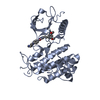
 Links
Links Assembly
Assembly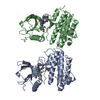
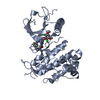

 Components
Components / FGFR-1 / Basic fibroblast growth factor receptor 1 / bFGF-R-1 / Fms-like tyrosine kinase 2 / FLT-2 ...FGFR-1 / Basic fibroblast growth factor receptor 1 / bFGF-R-1 / Fms-like tyrosine kinase 2 / FLT-2 / N-sam / Proto-oncogene c-Fgr
/ FGFR-1 / Basic fibroblast growth factor receptor 1 / bFGF-R-1 / Fms-like tyrosine kinase 2 / FLT-2 ...FGFR-1 / Basic fibroblast growth factor receptor 1 / bFGF-R-1 / Fms-like tyrosine kinase 2 / FLT-2 / N-sam / Proto-oncogene c-Fgr
 Homo sapiens (human) / Gene: FGFR1, BFGFR, CEK, FGFBR, FLG, FLT2, HBGFR / Production host:
Homo sapiens (human) / Gene: FGFR1, BFGFR, CEK, FGFBR, FLG, FLT2, HBGFR / Production host: 
 Escherichia coli (E. coli)
Escherichia coli (E. coli) receptor protein-tyrosine kinase
receptor protein-tyrosine kinase Sulfate
Sulfate Water
Water X-RAY DIFFRACTION / Number of used crystals: 1
X-RAY DIFFRACTION / Number of used crystals: 1  Sample preparation
Sample preparation
 SYNCHROTRON / Site:
SYNCHROTRON / Site:  Australian Synchrotron
Australian Synchrotron  / Beamline: MX1 / Wavelength: 0.9537 Å
/ Beamline: MX1 / Wavelength: 0.9537 Å : 0.9537 Å / Relative weight: 1
: 0.9537 Å / Relative weight: 1  Processing
Processing :
:  MOLECULAR REPLACEMENT
MOLECULAR REPLACEMENT Movie
Movie Controller
Controller




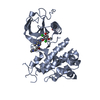
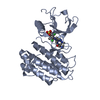
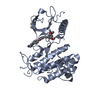



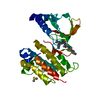
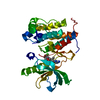

 PDBj
PDBj













